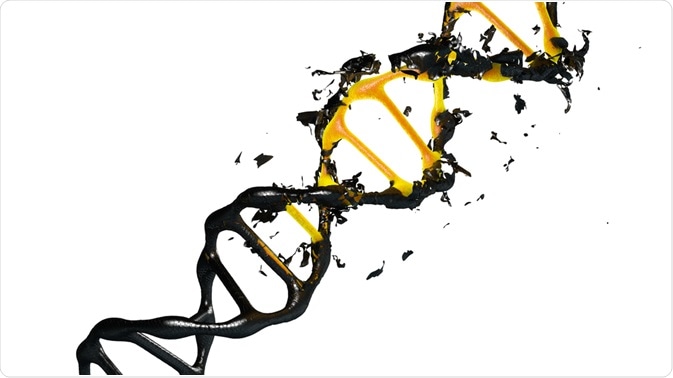Forensic samples that have been damaged or purposefully destroyed must be repaired for analysis and use in court. Several methods exist that can repair this damage.

Pinhead Studio | Shutterstock
Cell death and DNA degradation
Cell death activates different intracellular enzymes, such as lipases, proteases, and nucleases. Lysosomes, that contain hydrolytic enzymes, can break down biomolecules like histone proteins. The removal of histone proteins in turn facilitates the action of endonucleases that can cleave DNA.
Nucleases released by microorganisms in the environment further degrade DNA fragments, and an increase in free cytosolic calcium activates phospholipases that degrade membrane and lead to the release of more degradative enzymes. Thus, widespread DNA damage is imminent post-death.
PCR amplifying degraded DNA
The issues concerning the PCR of degraded DNA may be attributed to three problems: failure in amplification, preferential amplification, and miscoding lesions. To identify short tandem repeats (STRs) in DNA requires at least 1 ng of DNA and 28–30 amplification cycles.
Amplification can be improved by the addition of Taq polymerase, and extra cycles of PCR. In the case of degraded samples, shorter amplicons may be amplified more frequently, because longer amplicons are degraded. This is referred to as preferential amplification. To overcome this issue, alternative technologies, such as time of flight mass spectrometry or microchannel electrophoretic separation can be used.
Mitochondrial DNA (mtDNA)
The analysis of mitochondrial DNA (mtDNA) has been considered as an alternate strategy to identify genomic DNA. This circular DNA is present in the cytoplasm of mitochondria and more than one copy of mtDNA may be present in the mitochondria.
Most mammalian cells may have 200–1700 mtDNA copies, which make it very useful for investigations involving degraded DNA samples of humans – especially for skeletal remains, including bones, teeth and fingernails.
Improvements in pre-PCR and PCR methods
For samples with low copy number, repeated extractions and amplifications are performed to reduce errors. Other methods include reduction in the PCR volume, increase in PCR cycle number, nested PCR, amplifying the whole genome before PCR, removing ions after the amplification step, or increasing the time of injection during the process of capillary electrophoresis. Another strategy is also increasing the concentration of the primer. To identify missing people or human remains, low copy number typing may be performed.
What are some DNA repair methods?
Strategies may also be employed to reduce the damage to the DNA, although these methods are currently limited. One method involves repairing the DNA in the pre-PCR stage, where the nicks are translated by E. coli DNA polymerase I and the gaps are closed by T4 DNA ligase. Such methods where two concerted enzymes are used can only be employed in the presence of a 3’ OH or 5’ P terminus that has not been modified. These can be elongated and sealed by DNA polymerase I and T4 DNA ligase, respectively.
Another method is multiple displacement amplification, where the whole genome can be amplified using small levels of genomic DNA. This is achieved by isothermal amplification using a bacteriophage DNA polymerase.
Crosslinks between sugars and other components have been shown to be removed using N-phenyl thiazolium bromide (PTB). However, in some cases, it has been observed that PTB can also cause PCR inhibition and removal.
How can DNA be preserved or prevented from undergoing further decay?
Methods to preserve and prevent further degradation, include a dry environment, because the presence of water and moisture encourage the growth of bacteria and further damage. Similarly, low temperature may also preserve and restrict the DNA damage, as it reduces the rate of nucleotide base decomposition.
Further Reading
Last Updated: May 17, 2023